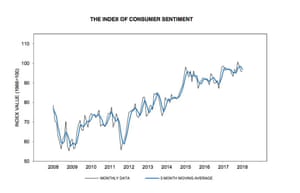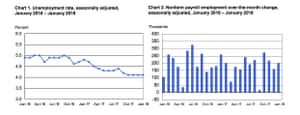
A quick summary of how bad it has been this week for US markets:
Jamie McGeever
✔@ReutersJamie
Wall Street on course for its worst week in 2 years: Dow -2.7% this week, S&P 500 -2.5%.
Bond yields posting biggest weekly rise since US election in Nov 2016: 10y yield +18 bps (to a 4-year high of 2.85%), 30y yield +16 bps.
9:48 PM – Feb 2, 2018
11 Reply
11 Retweet
44 likes
15m ago16:09
Back with bitcoin, and it has been through the classic rollercoaster ride today.
Having fallen as low as $7625 it is now actually in positive territory for the day, up 0.12% at $9010.
37m ago15:47
More on the disparities in the US wage growth data:

Danske Bank Research@Danske_Research
Higher wage growth, yes… but for whom? Mainly supervisors (18% of private employment), not ordinary workers (82%) $EURUSD $USD #reflation
8:29 PM – Feb 2, 2018
44 Replies
77 Retweets
44 likes
1h ago15:27
Connor Campbell, financial analyst at Spreadex, said”
The US open made a miserable day all the worse for the European markets, while Bitcoin managed to pull back from the brink.
Following Wednesday’s hawkish hold from the Federal Reserve, there was arguably more interest in this non-farm Friday than there has been for a while. And, luckily for the ailing dollar, the numbers didn’t disappoint: the headline figure came in at 200k, far higher than both the 181k expected and the 160k posted in January, with wage growth also outperforming forecasts to remain unchanged at 0.3%.
This, alongside a better than expected consumer sentiment reading from the University of Michigan, allowed the dollar to regain some ground lost this week. Against the pound the greenback rose 1%, sending cable back below $1.413, while against the euro the dollar jumped 0.7%, taking the currency away from yesterday’s $1.25-crossing 3 and a bit year peak.
All this hawkishness was toxic for the Dow Jones, which plunged 300 points once the bell rang on Wall Street to hit 25900 for the first time in over a fortnight. This Dow drop only exacerbated the losses in Europe; the DAX and CAC both fell 1.3%, with the former on track for its worst close since September last year, while the FTSE slipped 0.7% to strike a sub-7450, near 8 week nadir.
As for Bitcoin, while things are still bad, they are nowhere near as disastrous as they were at lunchtime. It had at one point found itself trading at $7750, a price not seen since the end of November, only for a wave of buyers to rescue it from those lows and send it back above $8650. Still, it’s certainly been a week to forget for the cryptocurrency, with a hat-trick of bad news – a shift in regulations in South Korea, a Facebook ban on ads for the product, and an investigation by the US CFTC – causing it to shed around $3000 per Bitcoin.
1h ago15:27
Since you’re here … we have a small favour to ask. More people are reading the Guardian than ever but advertising revenues across the media are falling fast. And unlike many news organisations, we haven’t put up a paywall – we want to keep our journalism as open as we can. So you can see why we need to ask for your help. The Guardian’s independent, investigative journalism takes a lot of time, money and hard work to produce. But we do it because we believe our perspective matters – because it might well be your perspective, too.
If everyone who reads our reporting, who likes it, helps fund it, our future would be much more secure. For as little as £1, you can support the Guardian – and it only takes a minute. Become a monthly supporter or make a one-off contribution. – Guardian HQ
1h ago15:21
With the dollar recovering in the expectation of an imminent US interest rate rise, the pound has lost some of its recent gains.
Sterling is down more than 1% on the day against the dollar to $1.4119, its biggest daily fall since November last year.
1h ago15:17
The university of Michigan’ survey may have come in better than expected but it did show the consumer sentiment index at its lowest level since September. However chief economist Richard Curtin was positive about the overall picture:
Consumer sentiment has remained largely unchanged for more than a year at very favorable levels. The January Sentiment figure was just 0.2 Index-points below December’s, and just 1.1 points below the 2017 average of 96.8–which was the highest yearly average since 2000. Stock price increases and the passage of tax reforms were mentioned by all-time record numbers of consumers. To be sure, there were small offsetting declines among lower income households and residents of the Northeast.
Consumers continued to expect growth in jobs and incomes, but anticipated a slightly higher inflation rate. Importantly, the motivating force behind purchase decisions has shifted from discounts on prices and interest rates to increased confidence in future job security and growth in wages as well as financial assets. This renewed sense of confidence was responsible for the recent declines in savings rates.
he tax cuts will increase discretionary spending once higher energy bills due to the unusually cold weather are paid. Monetary policy will need to tighten in the year ahead, but given consumers’ decade long experience with record low interest rates, only modest increases in interest rates will be sufficient to curb any excesses. Overall, the data signal an expected gain of 2.8% in real personal consumption expenditures during 2018.

Updated at 3.17pm GMT
1h ago15:08
The upbeat consumer confidence figures have sent Wall Street even lower, with the Dow Jones Industrial Average now down 300 points or more than 1.1%.
Updated at 3.09pm GMT
1h ago15:07
US consumer confidence remains strong
More positive news for the US economy, adding to the belief that the Federal Reserve will be ready to raise interest rates next month.
The University of Michigan consumer sentiment index came in at 95.7 in January, up from an initial reading of 94.4 and better than the expected figure of 95. It was however slightly lower than December’s final reading of 95.9.
1h ago14:57
Jasper Lawler, head of research at London Capital Group, suggests the slump in bitcoin could be one of the reasons for the current weakness in global stock markets:
Markets participants found themselves in the rare position of witnessing falling prices this week. It has naturally sparked questions of whether a larger correction is in store. The Dow Jones has pulled back 3% while the FTSE 100 has dropped nearly 4.5%. These are relatively small moves and based on recent experience, the mostly likely scenario is dip-buyers step in to send markets back up again. However, maybe this time will be different. The market has reached some new extremes in sentiment during January and certain risk-factors, notably the rise in bond yields, could point to further stock market declines.
It’s conceivable that the Bitcoin bubble bursting has meant retail equity investors were meeting less margin calls.
Rising bond yields have put stock markets on high alert. 2.6% was the first ‘worry level’ in 10-year US treasuries. A 3% 10-year treasury yield is the big kahuna for a larger stock market correction. After many stops and starts in US interest rate rises, investors increasingly seem to be feeling like this tightening cycle could be here to stay. The phenomenon is global though. The UK gilt yield has hit its highest since May 2016. India’s 10-year bond yield hit a fresh 22-month high. Rising interest rates mean the ‘goldilocks’ scenario for markets is warming up to ‘daddy bear’.
2h ago14:36
Wall Street opens lower
As expected US markets are in negative territory after the better than expected jobs figures gave a boost to the flagging dollar.
The Dow Jones Industrial Average is currently down 217 points or 0.8%, on track for its worst weekly performance since January 2016..The S&P 500 opened down 0.6% while the Nasdaq Composite was 0.55% lower.
2h ago14:28
The rise in average earnings is not spread across the board:
Jay C. Shambaugh@JayCShambaugh
anyone else notice that hourly earnings for production and non-supervisory workers was up just 2.4% y/y (table B8) ? right about where it has been for a while?
The headline series is up 2.9%, but the one that is the bulk of regular workers is not up as much.
7:49 PM – Feb 2, 2018
Replies
99 Retweets
1616 likes
2h ago14:20
Here are the jobs data charts:

Updated at 2.20pm GMT
2h ago14:11
Pantheon economist Ian Shepherdson reckons the jobs data should be good for shares.
Ian Shepherdson
✔@IanShepherdson
If productivity growth can keep up with the rise in wages, these numbers ought to be good for stocks. More wage gains = more revenue; steady unit labor cost = no margin hit, so earnings should rise.
7:34 PM – Feb 2, 2018
22 Replies
22 Retweets
44 likes
Ian Shepherdson
✔@IanShepherdson
Replying to @IanShepherdson2. Rising yields because of normalization/gradual rebound in neutral rate shouldn’t be a problem for stocks. A surge in yields because of inflation panic is a different story, but it’s not this one.
(At this point.)
7:36 PM – Feb 2, 2018
11 Reply
33 Retweets
44 likes
2h ago14:08
Wall Street futures have improved as we approach the opening of the US market.
The Dow Jones Industrial Average is now forecast to open around 200 points lower, better than the 250 loss predicted in the immediate aftermath of the better than expected jobs figures.
2h ago13:57
Kully Samra, UK managing director at Charles Schwab expects US rate rises this year. And increased market volatility:
The US economy started 2018 on a positive note as the labour market continues to tighten. This latest set of job numbers supports the view that that some of the weakness in December’s service-providing industries would revert in January.
Tightening labour market conditions and indications of a pickup in wage growth will be welcomed by the Fed which has expressed concern over benign inflation. While the Fed held interest rates steady on Wednesday, we expect a hike in March as Jerome Powell is expected to continue down the familiar path of keeping inflation under control without raising rates so far or so fast as to stifle the improvement in growth expected this year.
We continue to believe the Fed will hike rates at least three times this year and that, along with the paring of its balance sheet, historically-low financial conditions may start to tighten. However, with the outlook for inflation continuing to be carefully monitored, we do expect a higher level of volatility in the stock market this year relative to 2017.
The big picture is that America’s economy has been creating jobs each month since early into Barack Obama’s first term, and it’s held steady under Donald Trump too.
source:-the guardian
